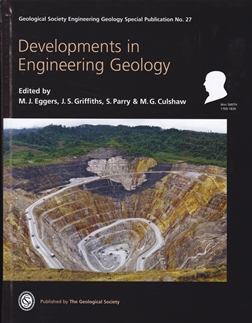Developments in Engineering Geology

The 20 chapters in this volume are a series of case studies arising from the 34th International Geological Congress (‘34IGC’) in Brisbane, Australia (2012). The chapters are from a range of contributors, including academics, government researchers, and consultants. The book is divided into five themes, reflecting the ‘34IGC’ symposia within which the work was presented: (1) urban engineering geology; (2) mining engineering geology; (3) managing geohazard risk; (4) geological models; (5), geomechanics. Hence, a broad range of topics are covered, and the index at the back of the volume will be useful for readers who want to dip into specifics.
The first chapter by Eggers will be useful for those new to engineering geology. It provides useful discussions on relationships between geology and engineering, which tends to vary depending on the part of the world you work in, and the local relevance of professional accreditation. Eggers also provides a history of how engineering geology has evolved, outlining some of the organisations intrinsic in its development. For engineering geology novices, this provides a platform with which to explore the rest of the book, while others may delve straight into the individual chapters. My favourite chapter is on geotechnical issues at an open-cut coal mine in the Late Permian Baralaba Coal Measures in Queensland, Australia. It presents some of the longstanding issues that I and many other geologists have had to deal with there over the years. Such case studies from the Bowen Basin rarely make it into the international literature beyond an extend abstract in a conference proceedings, so to see a full-length paper is most welcome.
As is sometimes the case with edited volumes, the figures are of variable quality. The vast majority of figures are in black and white. This is somewhat of a pity, as some of the figures would have been enlivened with colour; several of the figures in Kozlyakova et al., for example, and this detracts from the book. Another thought is that there is a 4 year gap between the 34IGC and publication of this volume. New technology is emerging all of the time in engineering geology, given its position at the nexus of engineering and remote sensing disciplines. Hence, recent technological advances such as structure-from-motion (SfM) photogrammetry and other unmanned aerial vehicle (UAV) technologies are absent. Nevertheless, in summary this will be a worthwhile volume, and presents interesting case studies by eminent practitioners in the field of engineering geology.
Reviewed by Martin Brook
DEVELOPMENTS IN ENGINEERING GEOLOGY by M.J. EGGERS, J.S. GRIFFITHS, S. PARRY and M.G. CULSHAW (eds), 2016. Published by: Geological Society Engineering Geology Special Publication #27 253pp (hbk) ISBN: 9781862399723 List Price: £90.00. W: https://www.geolsoc.org.uk/SPE27.